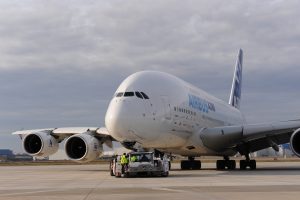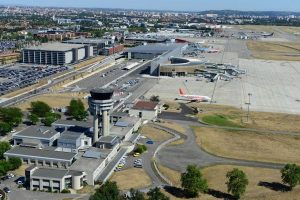Toulouse Blagnac Airport, like the region it represents, is truly an exception. This is where aircraft learned to fly over a century ago, on the same runways now used to send more than 7.5 million passengers into the friendly skies. Today, one of the aviation manufacturing capitals of Europe, Toulouse and the Midi-Pyrénées region can take pride in having assets with real appeal around the world! Thanks to a variety of attractive features, the city’s Blagnac Airport is the hub of one of France’s most dynamic regions and is producing consistent growth in spite of the economic crisis.
Set between the Pyrenees and the Mediterranean, and lying closer to Barcelona than to Paris, Toulouse and its region have forged their own unique personality – assertive, generous and cosmopolitan, like the people who live there. The harmony of the Pyrenees Mountains punctuated by the severity of Cathar castles, peaceful village squares bustling with crowds on market days; the land of rugby has a great deal of character.

But the region boasts exceptional famous places to visit beyond the 100 destinations available from Toulouse: Lourdes and the emotion of its sanctuary, the Pic du Midi for touching the stars, Carcassonne, the medieval city where make-believe comes to life, the Canal du Midi linking the Atlantic and the Mediterranean, and the “giant step” of the Millau viaduct, the highest roadway bridge in the world. And thanks to 28,000 km of hiking trails, including the Santiago de Compostela pilgrim routes, the list goes on and on, and the way there is more and more beautiful!
The region’s economic life beats to the same rhythm. By its vastness, diversity, historical wealth, and intellectual and industrial potential, it holds a strategic economic place at both the European and global levels. With a population of 3.3 million, 30,000 new inhabitants per year, and an expected population growth of 19 per cent by 2030, it is one of France’s most vibrant regions, both demographically and economically.
The aerospace sector now represents some twenty aeronautical manufacturers and OEMs, and almost 550 plants indirectly connected to this industry, counting over 50,000 employees. The entire chain is represented, from design offices to end-of-life aircraft dismantling. In terms of the stars, the region has also become one of the major international hubs for space exploration. The know-how of CNES engineers who helped develop the famed robot Curiosity has made it all the way to Mars. In all, space construction represents 22,500 employees and more than 200 companies.
But Toulouse and its region also know how to diversify, and the food processing and research industries are as much on the cutting edge as Oncopôle, the only cancer research centre of its kind in Europe, bringing together academic, scientific, technological, medical, clinical, pharmaceutical, public and private expertise.
In the heart of this rich region, the Toulouse Blagnac Airport is a platform bursting with energy and ambition. 29 scheduled airlines and 22 charter airlines are the major players in this dynamic trend. They are pumping life into the sector and in 2012 the airport expanded its destination offer by opening up 35 new routes, increasing traffic by 8.2 per cent. It is also the leading provincial freight airport, with more than 59,440 tonnes of cargo processed in 2012.
The airport says it support the development of airline partners “with imagination, responsiveness, options and commitment” and the following case studies highlight examples of recent achievements from this strategy. Relating to Imagination, in June 2012, the airport took part in an event for Air France in Toulouse city centre, as part of the airport's marketing action plan. 2,000 participants became ‘virtual passengers’ in a flight simulation to the new "summer" destinations opened up by the airline, departing from Toulouse and the activity was seen by thousands of spectators and recognised by the leading French communications magazine Stratégies.
In terms of commitment: to encourage airlines to develop new routes departing from Toulouse, It offers a reduction in passenger fees and landing charges of 70 per cent the first year, 50 per cent the second year and 30 per cent the third year, while on the matter of responsiveness and options, at the end of March 2012, in preparation for the strong passenger growth expected due to the opening of the Air France and easyJet bases the airport reorganised the location of the airlines in its four halls (A-B-C-D).
This change happened overnight. For departures, new traffic flows were rolled out to passengers for faster and easier boarding access. Today, the airport can handle walk-in and walk-out traffic simultaneously, so an A319 stop-over takes just 25 minutes for low-cost airlines. It has also increased the number of passenger gangways to meet the expectations of traditional airlines in terms of both quality and comfort.

It is impossible not to mention the close and fruitful professional partnership Toulouse Blagnac has developed with its neighbours Airbus and ATR. It offers them an ultra-modern platform for their trials with its two runways capable of handling even the largest aircraft which are assembled in and take-off from Toulouse, in the form of the A380. In recent years around €15 million has been invested in Runway 1 for the forthcoming flight trials for the new A350.
Passengers didn't vote Toulouse Blagnac Airport ‘Best Airport in France 2012’ by chance. This award recognises a constant obsession, a real corporate culture, to make the passenger's journey as seamless as possible by eliminating wasted time. “Boredom and impatience are not included in our service,” one senior airport executive claimed. “With over 7.5 million passengers come just as many different ways of travelling, which is why we decided a long time ago not to single out any one in particular, but to address them all,” he added.
The airport no longer want customer journeys to begin once they enter the airport, but “whenever and wherever they want it to from the moment they hook up to the Internet”. Reserving a parking space on the web is already possible, estimating wait times at the security checkpoints from the car park is already up and running as well.
“Our airport is a journey in itself, before you even set foot on the plane. Its shops and restaurants are a delight for the senses; its contemporary art exhibitions bring a touch of culture; it has entertaining children's activities and workshops, and Airport Helpers come to the aid of unseasoned passengers for a stress-free experience,” said the airport executive.
For business travellers, the airport is an extension of the office thanks to a dedicated ‘business area’ with all the necessary connections. Fans of interactive technology will love the NFC (Near Field Communication) experiment: a world first which lets you connect to a multitude of services inside the airport with your smartphone. A new website is planned for launch this month with dedicated applications for smartphones and tablets, and will make life even simpler for our customers who, in just a few clicks, will be able to book holidays, tickets, parking spaces, and even access the airport’s new La Croix du Sud lounge. As far as shopping is concerned, the airport will soon be welcoming FNAC, chocolate maker Jeff de Bruges, SWATCH, AELIA MODE and AELIA BEAUTE as well as a Casino Shop grocery and SAFEBAG to expand our offer to passengers.

The aviation marketing team at Toulouse Blagnac is now working to bring additional partners to the airport and is focusing on developing markets with high potential for growth, such as the long-haul market, with objectives such as United Arab Emirates, the United States and New York in particular, as well as Asia in general. These destinations enjoy very high O&D traffic rates and are balanced in terms of passenger type, with a significant portion of business passengers. The high rates of connection traffic are also a key asset for these future routes.
For the past few years, the countries of Scandinavia and Eastern Europe, and Russia, like the Midi-Pyrénées region, have been experiencing major growth in terms of trade and industrial, tourism and cultural exchanges so remain strong future network targets. Additionally, among the residents of Midi-Pyrénées, there is great enthusiasm for projects involving destinations with high VFR and leisure potential, such as Dakar, Tel Aviv, North Africa, and French Overseas Departments and Territories.
The airport is also working to add to its low-cost offering. The very high growth in this sector over the past few years illustrates the growing tourist appeal of Midi-Pyrénées, which is an asset for growth in import clientele. In addition, the large catchment area around Toulouse holds great potential for stimulating traffic for VFR and leisure travellers, in order to offer something for everyone balancing both inbound and outbound dynamics. Toulouse Blagnac claims to be “forging the future”, but its growth plans are far from finished!
The tables below highlight the top ten destinations and largest operators from Toulouse Blagnac by seat capacity last year. Its largest user is national carrier Air France which accounts for more than 40 per cent of the total seat capacity on offer, growing to more than 50 per cent when you incorporate its regional partners some of which now fly under the unified Hop! easyJet has increased its own share of the market after opening a base at the facility in 2012. In terms of airports, the Parisian gateways of Orly and Charles de Gaulle dominate the analysis with Madrid Barajas the largest international destination by capacity.
|
SCHEDULED AIR SERVICES FROM TOULOUSE BLAGNAC AIRPORT (non-stop departures; 2012) |
||||
|
Rank |
Airline |
Flights |
Seats |
% Capacity |
|
1 |
Air France (AF) |
14,140 |
2,226,595 |
44.2 % |
|
2 |
easyJet (U2) |
6,297 |
1,024,860 |
20.3 % |
|
3 |
Lufthansa Cityline (CL) |
2,356 |
202,198 |
4.0 % |
|
4 |
British Airways (BA) |
1,106 |
145,112 |
2.9 % |
|
5 |
Regional (YS) |
1,771 |
141,352 |
2.8 % |
|
6 |
Air Nostrum (YW) |
1,828 |
133,710 |
2.7 % |
|
7 |
Brit Air (DB) |
1,770 |
128,084 |
2.5 % |
|
8 |
KLM Cityhopper (WA) |
1,308 |
121,720 |
2.4 % |
|
9 |
Airlinair (A5) |
1,547 |
87,715 |
1.7 % |
|
10 |
Vueling Airlines (VY) |
591 |
86,580 |
1.7 % |
|
TOTAL |
40,298 |
5,042,066 |
- |
|
|
SCHEDULED AIR SERVICES FROM TOULOUSE BLAGNAC AIRPORT (non-stop departures; 2012) |
||||
|
Rank |
Airline |
Flights |
Seats |
% Capacity |
|
1 |
Paris Orly (ORY) |
9,468 |
1,560,060 |
30.9 % |
|
2 |
Paris Charles de Gaulle (CDG) |
3,146 |
499,594 |
9.9 % |
|
3 |
Lyon Saint Exupéry (LYS) |
2,133 |
288,971 |
5.7 % |
|
4 |
Madrid Barajas (MAD) |
1,928 |
171,994 |
3.4 % |
|
5 |
London Gatwick (LGW) |
986 |
155,952 |
3.1 % |
|
6 |
Nantes Atlantique (NTE) |
1,573 |
145,478 |
2.9 % |
|
7 |
London Heathrow (LHR) |
1,106 |
145,112 |
2.9 % |
|
8 |
Munich Franz Josef Strauss (MUC) |
1,519 |
141,316 |
2.8 % |
|
9 |
Frankfurt am Main International (FRA) |
1,403 |
125,352 |
2.5 % |
|
10 |
Lille Lesquin (LIL) |
1,217 |
122,851 |
2.4 % |
|
TOTAL |
40,298 |
5,042,066 |
- |
|
** FOR MORE INFORMATION ON TOULOUSE BLAGNAC AIRPORT PLEASE VIEW THE AIRPORT'S ROUTE EXCHANGE PROFILE **
